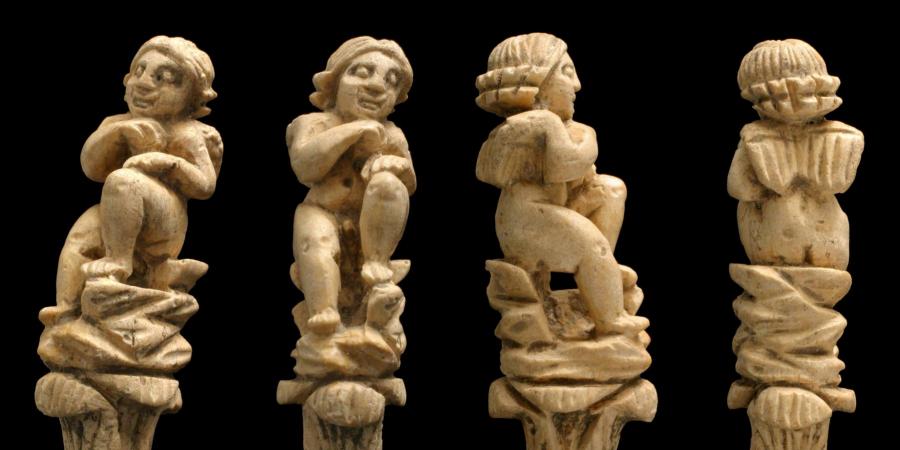50.717450729587, -2.4560035765171
One major discovery by Wessex Archaeology was a Roman mosaic dating to about 350AD at the former County Hospital site in Dorchester in Dorset.
Dorchester has preserved many archaeological finds from its Roman past when it was called Durnovaria. Before building work began on the hospital site, Wessex Archaeology was asked to excavate for possible remains. The excavation, carried out in 2000 and 2001, was the largest archaeological investigation of the town for many years.
Excavation on the eastern side of the site revealed that wooden buildings had been put up in the mid-1st century. Slots for timber beam-foundations and rubbish pits were found, as well as two stone-built ovens.
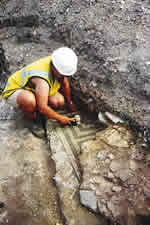

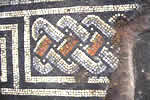
Soil removed from the ovens was found to be full of herring bones so they may have been used for making a strong fish sauce called ‘garum’, an essential part of Roman cooking.
We found evidence of houses built in the 2nd or early 3rd century AD, including the remains of an external courtyard with a stone-lined well. These buildings were demolished in the 4th century and replaced by a new range to the west.
This range comprised at least two buildings set around a courtyard. One of the buildings contained the remains of a fine multi-coloured decorative mosaic floor measuring some six by four metres that has excited interest among archaeologists and the public since.
On the 21st July 2001 – National Archaeology Day – the site was opened for public viewing and some five thousand people queued to see the mosaic before it was lifted for future conservation.
The final phase of excavation exposed remains of a large barn or warehouse constructed from timber set on stone plinths.
These discoveries provided information about the development of the Roman town and were of great importance both to the academic study of the Roman period and to the wider public understanding of Dorchester’s past.
A book is available on the Dorchester Hospital excavations, and the specialist reports are available to download below.
The finds
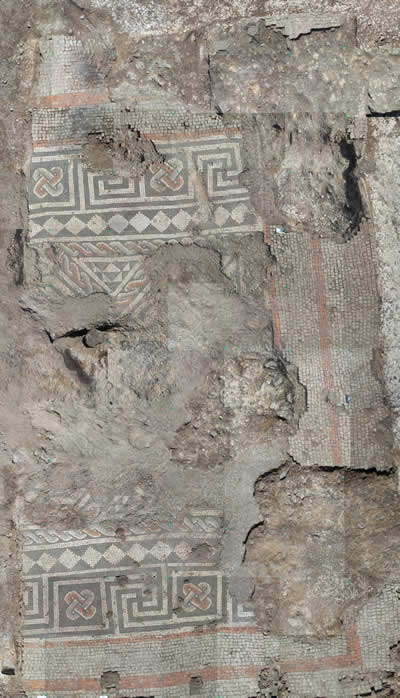
Mosaic floors were found in the later building on the site, a wealthy ‘town house’ set back from the road on a levelled terrace cut deep into the hillside.
The style of the mosaics has helped date the building to the middle of the 4th century AD.
The surface of the floors had been ground to a fine smooth polish. It is very unusual to find floors with such a high degree of finish in the region and suggests that the owner of the house was a man of substance.
Years later the building had fallen into disrepair and open fires were laid on the beautiful mosaic floors, leaving their scorch marks as evidence.
The mosaics were carefully lifted so that they can one day be put on display.
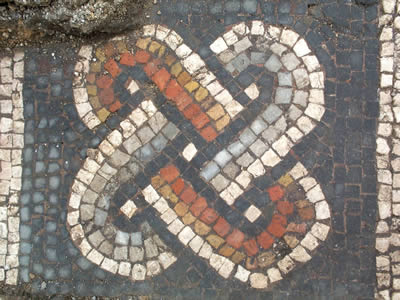
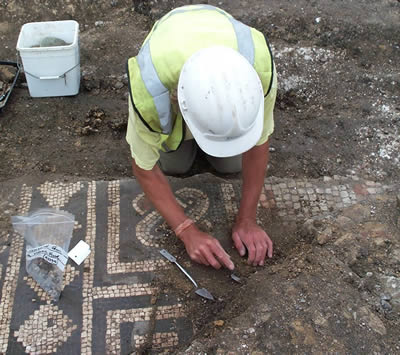
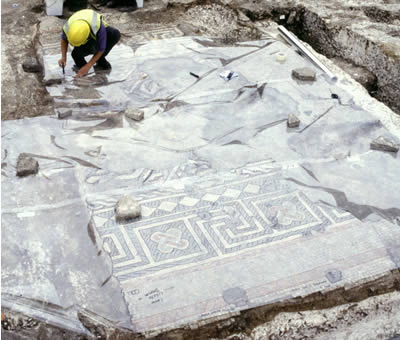
The Walls
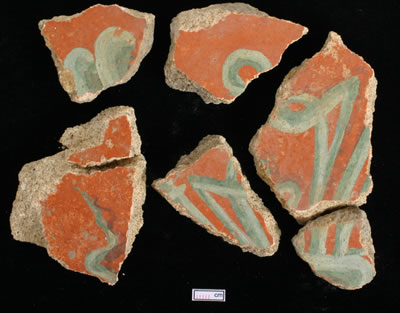
Many pieces of both plain and decorated wall plaster were recovered from the site. Fragments of plaster with a wide range of colours and designs came from the area of the later building, adding to our picture of a handsome town house, with principal rooms decorated with painted walls and mosaic floors.
Panel designs are the most common form of plaster decoration found in Britain. Pigments were made from chalk, soot, and natural stones and earths. The colour was either applied to wet plaster (fresco), or mixed with a medium such as egg white, beeswax or animal glue (tempera), to make it stick to the surface.
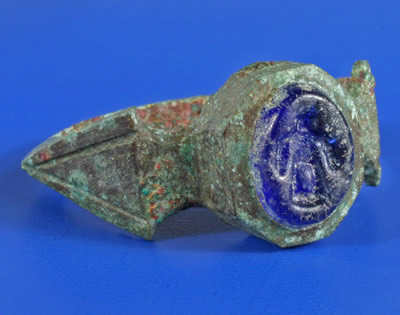
Rings
Members of metal detecting clubs in Weymouth, Stour Valley and Yeovil helped to search the site. Amongst the metal finds were coins and rings.
One of the 13 rings had an intaglio (a carved or engraved gem) in the form of a human figure, made from translucent, dark blue glass. It probably dates from the early 1st or 2nd century AD.
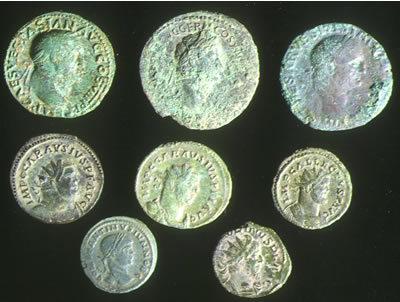
Coins
Coins found on site span the entire Roman period in Britain from the 1st to the 5th century AD. The dates of the coins and the places where they were found are very useful in showing us how the site developed and when different parts of it were in use.
The largest number of coins was found in the barn or warehouse, where they had been hidden at the beginning of the 5th century AD.
Hairpins
Beautiful hairpins were carved from animal bone. Pins with intricate designs like these would have been expensive and highly prized. The pins found on the site span the period of Roman Britain but the largest number date from the second and third centuries AD.
Lamp
This little oil lamp is made from colour-coated ware (the hardened clay is dipped in coloured slip before firing). It comes from the earlier building on the site, one of the houses bordering the western side of the street.
The handle by which it was once carried is now broken, as are the small lugs on either side which held cords to suspend it when lit. The face decoration above the oil chamber is just visible.
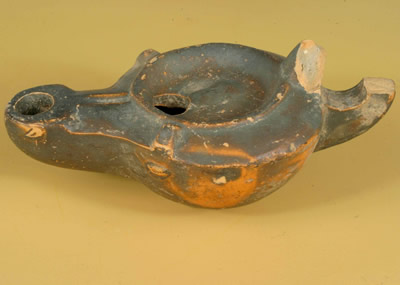
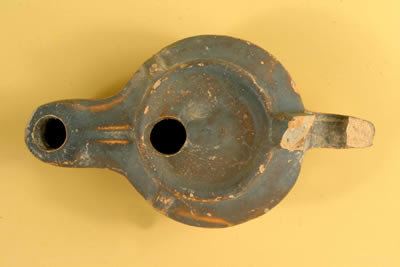
Seal Box
This little seal box probably dates from the 2nd or 3rd century AD. It is made of copper alloy. Seal boxes were used to protect official documents or personal letters. A cord was wrapped around the document and through the holes in the sides of the box. It was secured with sealing wax poured into the box and stamped with a seal (probably from a finger ring).
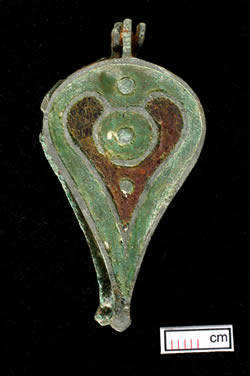
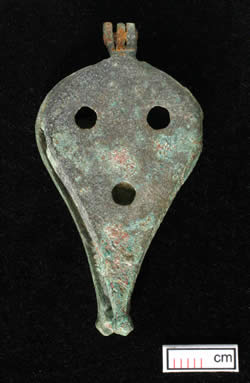
Post-excavation
Post-excavation answers many questions, but some intriguing ones remain. Was the late Roman town house in use when the Roman government withdrew from Britain? Or was there a decline in the fortunes of Dorchester before that? Did the house continue to be used after the Romano-British period? What can further study of the coins tell us about the monetary economy in the closing years of Roman influence? And the barn/warehouse poses questions too. What agricultural activities took place there, and how ‘rural’ was the Roman town of Dorchester?
We are now doing the final analysis of the finds from the Dorset County Hospital site to try to answer some of these questions. We hope the results will be published in an illustrated book about this interesting site.
Specialist reports
Suburban life in Roman Durnovaria: Excavations at the former County Hospital Site, Dorchester, Dorset 2000–2001
Suburban life in Roman Durnovaria: Excavations at the former County Hospital Site, Dorchester, Dorset 2000–2001 is a new Wessex Archaeology publication that presents the results of these important excavations. Evidence for prehistoric activity is summarised and the development of the town and its changing layout through time are examined. Finds and environmental evidence are used to examine the activities that were being undertaken in the town. This section of the website contains the specialist reports and selected plans of the site.
Introduction
A scheme to regenerate the County Hospital site led to a series of archaeological excavations in autumn 2000–1, enabling the south-western corner of the Roman town of Durnovaria to be examined. Numerous small-scale excavations have been undertaken in the past within the Roman town together with some larger-scale excavations. Despite this work gaps in our knowledge of street layout and the town plan remained. The opportunity to examine a reasonably large area of this part of the town was therefore of some importance.
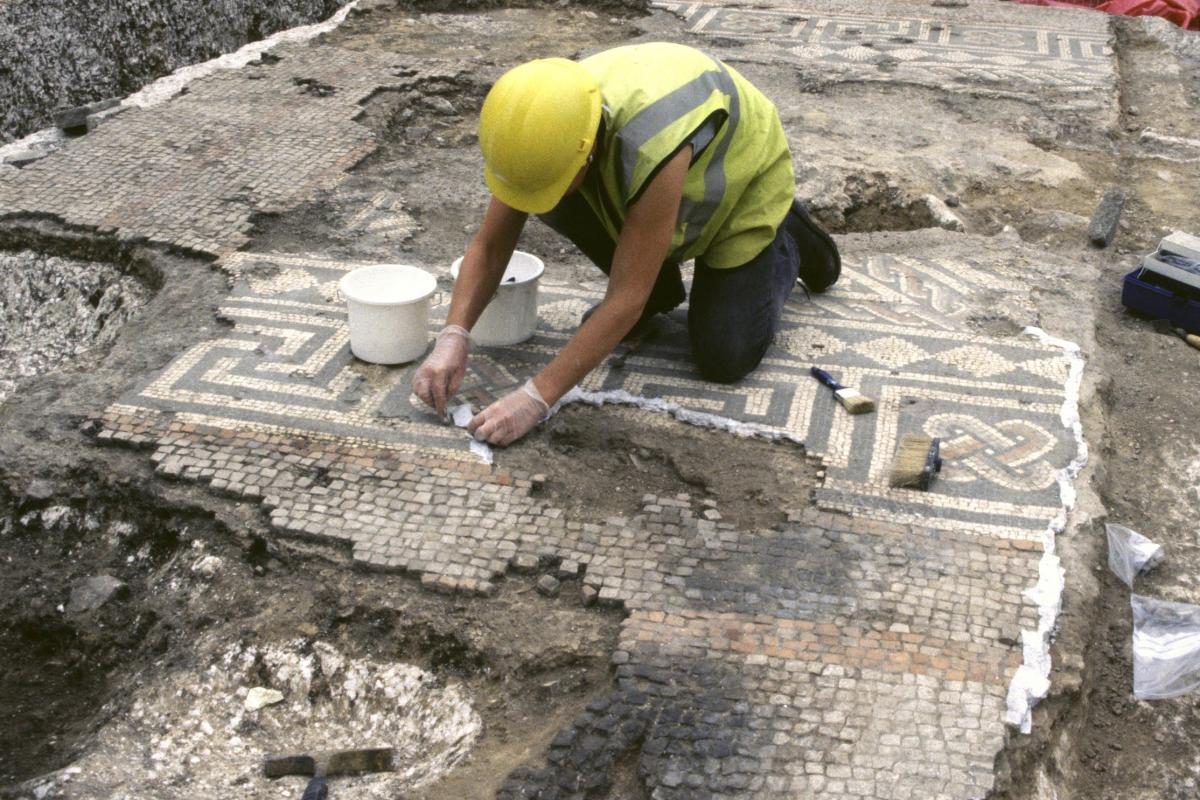
Suburban life in Roman Durnovaria: Excavations at the former County Hospital Site, Dorchester, Dorset 2000–2001
The book describes the results of the excavations, illustrating the development of buildings beside the Roman street. Amongst the stunning finds from the site are the beautiful mosaics, which have been painstakingly painted and described by Stephen R. Cosh, rare and exquisitely carved bone hairpins, and a gold ring. Other more mundane finds, have enable archaeologists to examine the everyday lives of the inhabitants. The environmental remains suggest that foodstuffs such as grain, wine or grapes and lentils were being imported from the continent. An important deposit of allec, a fish sauce, was also uncovered. The pottery from the site also sheds light on local industries as well as imported wares.
To purchase this publication follow this link
Index of specialist reports
1. Stratigraphic description of selected buildings and structures, by Mike Trevarthen
Building 4
Building 8
Building 9
Aisled Building 12
This report provides a more detailed description of selected buildings from the excavations.
Environmental
2. Wood charcoal, by Catherine Barnett (neé Chisham)
This report provides evidence for the types of wood being used in selected contexts. Wood from Oven 1470 seems to have been largely mature oak, which was damp when burnt. This may have been selected deliberately to increase the smoke to act as a flavouring.
3. Charred plant remains, by Chris Stevens
Charred plant remains from the site are summarised and discussed within the context of Roman Durnovaria. The possibility of some crops (grain and lentils for example) being imported from the continent is also discussed.
4. Eggshell, by Jane Sidell
Eggshell from selected contexts was examined and found to be of goose and hens.
5. Marine shell, by Sarah F. Wyles
The different marine species represented are summarised and their likely sources are discussed.
6. Fish bone from selected contexts, by Sheila Hamilton-Dyer
This report examines the fish bone evidence from selected contexts. The remains represent allec, a sauce made from small intact fish. This important find is discussed and comparative material summarised.
7. Animal bone, by Jessica M. Grimm
The faunal remains from the site are quantified and discussed by period. Information relating to animal husbandry within the town is discussed together with the evidence for wild species. The distribution of bone across the site and between feature types is discussed.
Finds
8. Pottery, by Rachael Seager Smith
The pottery from the excavations is quantified and discussed within the context of Roman Durnovaria. Interesting evidence for lighting (lamps, Tazza and candlesticks) is also presented.
9. The samian pottery, by J.M. Mills and the samian potters’ stamps, by Brenda Dickinson and J.M. Mills
The samian pottery is presented and discussed within its local context. Differences between the areas excavated were noted. An appendix provides details of the decorated samian. A catalogue of the samian potters’ stamps is provided.
10. Mortar and opus signium, by Kayt Brown
A summary of the mortar and opus signium is presented. Details of the opus signium-lined room in Building 8 are provided.
11. Painted plaster, by Kayt Brown
This summary report provides a quantification of the painted plaster, with details of some of the decorative schemes presented.
12 Ceramic Building Material (CBM), by Kayt Brown
A summary of the various types of ceramic building material found on the site is presented.
13. Mosaics Buildings 13 and 6, by Stephen R. Cosh
The mosaics from two of the Buildings are described in detail and a reconstruction of the design of the mosaic from Building 13 is presented. The superb paintings by Stephen Cosh are reproduced.
14. Glass, worked bone, shale and metalwork, by Matt Leivers
Detailed catalogues of the finds are presented together with a discussion of each category of material.
15. A late Roman coin hoard, by Nicholas Cooke
This report presents the evidence for the late Roman coin hoard and discusses it in the context other hoards found in the vicinity. The significance of these finds and the nature of the late Roman activity of the area is also discussed.
16. Human bone, by Jacqueline I. McKinley
A summary of the human remains is presented.
17. Flint, by Matt Leivers
The flint from the excavations is quantified and the assemblage has been characterised.
Project description
Excavations at the former County Hospital site, Dorchester have provided a rare opportunity to examine a reasonably large area of the south-western corner of the Roman town of Durnovaria. The results of the excavations have allowed the development of this part of the Roman town to be established more fully. The remains of several buildings, including a late Roman town house complete with fine mosaics, was recovered. Other structures, working areas and probable barns were also identified.
The excavations produced a wealth of artefactual evidence shedding light on the daily lives and activities of the inhabitants of the town. Imported items such as pottery were recovered together with some of the foodstuffs that may also have been brought from the continent. Important evidence for allec or fish sauce was recovered; this is the furthest west it has been found in the Roman Empire and one of only a few examples of this foodstuff from Britain. Other possible imported items include wine or vine fruits, olive oil, grain and lentils. Local produce and commodities were also consumed and used within the town including foodstuffs, livestock and regionally produced pottery and items such as shale. The evidence from previous excavations in the vicinity has also been used to set the results into context.
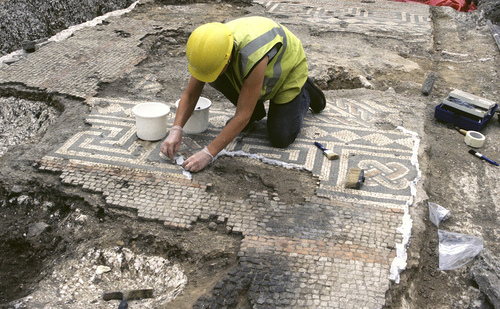
The excavations generated immense local interest and the open day proved so popular that many people queued for hours for a glimpse of the beautiful mosaics, buildings and artefacts revealed. With this in mind the results of the excavations are presented in the publication in a less formal manner than is usual for archaeological reports and we have included many photographs and images to allow a broader understanding of the archaeology to be conveyed. Technical reports on aspects of the results (selected stratigraphic descriptions), the finds end environmental reports are available on this website.
The excavations were undertaken in 2000-2001 by Wessex Archaeology and were funded by the developers Bentleigh Cross Ltd and monitored by CgMs consulting Ltd.
